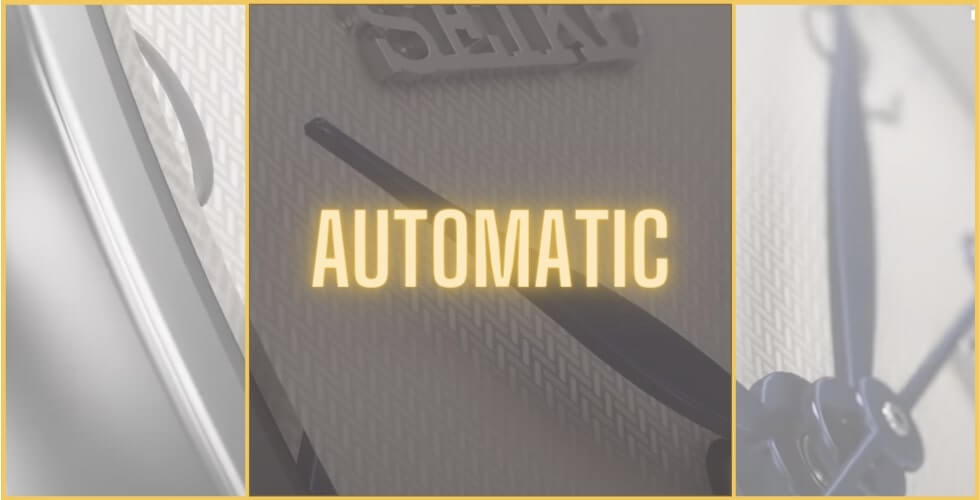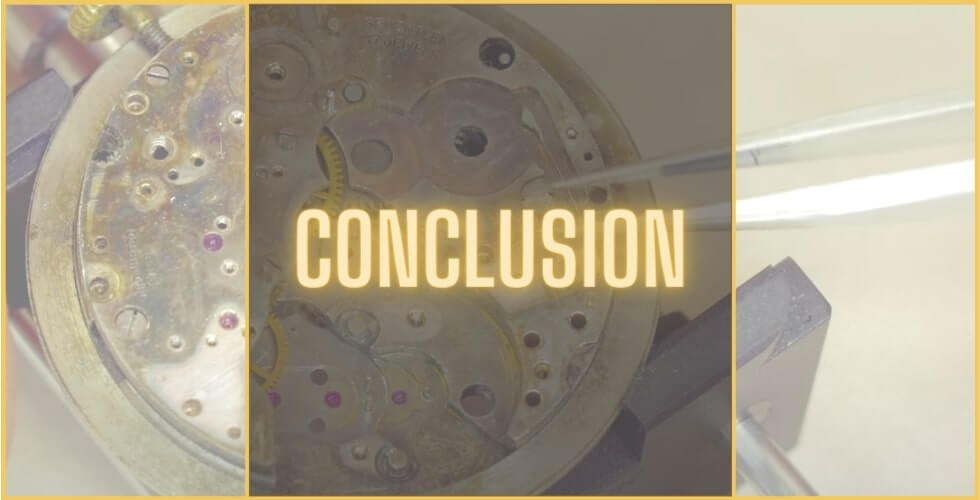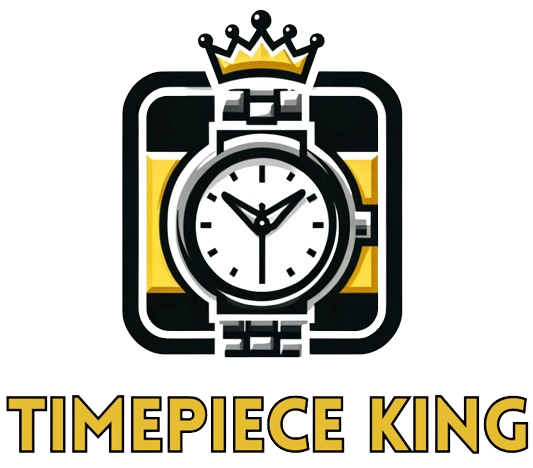If I had to pick one watch part even the most inexperienced buyer should know about, then I would point to the movement of the watch.
It’s the heart of every timepiece and as we know, once the heart stops, so does the rest. After reading this article, you will be able to differentiate between the three primary watch movement types and pick one that fits you best.
Movement, also often referred to as “caliber”, is the mechanism that drives the watch hands.
It’s also behind any other watch feature you can think of, such as a timer, alarm or calendar. It’s basically what makes the watch tick.
Some brands have their proprietary movement technologies and there are literally hundreds of watch movement manufacturers in the world.
Still, at the end of the day, it all comes down to just three watch mechanism types: mechanical, automatic, and quartz.
Each has its style as well as its list of positives and negatives. At the end of the day, different people will go for different mechanisms based on their preferences and needs. Hence, it’s extremely important to be able to distinguish between them and pick them accordingly.
Find all three watch movement types explained below.
Mechanical Watch Movement

Looking chronologically, the mechanical movement was the first to see daylight. It was the movement on which the first watch in the world operated and it’s been with us for centuries now.
There are two mechanical watch movement types: manually wound and automatic (which I will discuss in detail later).
The first type of mechanical watches, as the name suggests, needs to be wound in order to run. Manually wound watches are powered by the so-called “mainspring”. Once the spring is wound, it starts unwinding itself gradually. As a result, it starts driving all the gears responsible for the watch’s hands movement, as well as other complications.
It’s only fair to mention that this type of watch movement is the most time-consuming. For the watch to show the correct time, you will have to regularly dedicate a couple of minutes to wind it. Usually, a few turns of the crown will be enough to fully wind the spring and store the energy needed to work the mechanisms.
The power reserve in manual mechanical watches will differ, depending on the brand of the timepiece and the model. At the very least, it should be enough to fuel the watch for 24 hours. At the other end of the scale, there are some manually-wound watches that will run for a full week.
Most people who own mechanical watches, don’t really care how often they need to wind them. Many manually-wound watch owners are collectors, true watch dorks. For them, the whole process of playing with the intricate mechanism of such a watch is the reason why they bought it in the first place.
Even though the mechanical movement type is the oldest, watches that use it are often more expensive than quartz timepieces. The reason is simple: the number of hours a watchmaker has to dedicate to create a top-quality, manually-wound timepiece is just so much bigger.
More often than not, the material which the watch parts are made of is also of higher quality. Once you start browsing for manually-wound timepieces, you will notice that many of them come with beautifully-presented, transparent case backs through which you can watch and admire all the intricate mechanisms.
- Save on batteries – mechanical watches don’t ever require a battery. Once you learn how to love the process of winding the watch manually, the chances are you will never have to spend a dollar to keep the watch running.
- Iconic design – without a doubt, mechanical watches present the most beautiful and elaborate design. If you are a watch dork, it seems like the only right option to go for.
- Lifetime use – if taken proper care of, quality mechanical watches might serve you throughout your life.
Automatic Watch Movement

Next on the line are automatic watches. Some consider(ed) them to be an upgrade on the manually-wound timepieces but I’m pretty sure many of the retro-style enthusiasts will beg to differ on this one.
To put it very shortly, the automatic watch movement functions nearly identically to its predecessor. The only difference is that you won’t have to wind it so often – or not at all. Automatic watches are frequently referred to as self-winding because they wind themselves without you having to tinker with the crown.
How does the magic happen, then? Unlike manually-wound timepieces, watches with the automatic movement include a rotor. Putting it into the simplest terms possible, a rotor is an additional metal weight connected to the movement’s mechanism. When wearing the watch, your wrist moves, causing the rotor to twirl and transfer the energy necessary to wind the mainspring. Voila!
Even though the need to wind an automatic watch is nowhere near as frequent as a manually-wound one, you will still have to do it from time to time. As soon as you take the timepiece off your wrist, it will slowly start unwinding. After a short period of time, the accuracy will drop whereas with an extended break in wearing, it will come to a halt altogether. Worry not, the process of winding is just as smooth as in the case of the previous movement type.
If you have more than one automatic watch and you don’t want to wind it every time you put it on, then consider buying a watch winder. It’s a great device that mimics wrist movement, keeping your watch running all the time.
When you look at the design of automatic watches, many are just as elegant and elaborate as those that need manual winding. More often than not, they also will cost you more than a standard quartz watch. In fact, when you look at the luxury brands like Rolex, Omega or Tag Hauer, most of these watches are “automatics”. If that’s asking a bit too much of your budget, then consider cheaper automatic brands like Bulova or Tissot.
- Self-winding – in contrast to manually-wound timepieces, automatic watches don’t require frequent winding. The movement of your wrist provides enough energy for the watch to wind itself.
- Luxury choice – automatic movement type is the most frequent choice amongst many luxury brands. Moguls including Rolex or Patek Philippe are full of automatic timepieces
- Extremely stylish – just like old-school watches that need manual winding, timepieces with automatic movement tend to be extremely stylish. Most will boast a much more premium look than quartz watches.
Quartz Watch Movement

The freshest of them all. The introduction of the first quartz watch by a Japanese conglomerate Seiko sparked the so-called Quartz Crisis. Also referred to as the Quartz Revolution, it was a period of turmoil for most of the watchmaking brands caused by the arrival of the first quartz timepieces.
At that time, the advent of new technology noticeably decreased the need for mechanical and automatic watches. As of today, quartz movement models are still the most sold from all three. Over the last decade, though, a growing number of people seem to be appreciating the more complex mechanisms of mechanical timepieces.
Since the previous movement types relied on mechanical movement, it’s not hard to guess that quartz watches are battery-powered. The power in quartz timepieces is created by a battery that sends an electrical stream through a quartz crystal. As a consequence, the crystal is able to create vibrations which in turn keep the movement going.
Because they are battery-run, quartz watches require very little-to-zero maintenance over the years. At the same time, they are also much more accurate as they don’t rely on any outside force for the movement to run. In fact, some of the more premium models can boast an accuracy of just a few seconds a year.
Some quartz watches don’t need batteries. Many leading brands in the watchmaking industry, like Citizen or Casio, have developed lines of watches that are solar-powered.
Even though there’s no doubt that quartz watches are much more precise, cheaper and require less maintenance, they often lack the intricate craftsmanship and beauty so characteristic of mechanical timepieces. And this is probably the reason why they’ve been enjoying a true renaissance in the last decade or so.
- Accuracy – quartz watches are by far the most accurate. Because they don’t need your regular interference, they make sure you are always right on time.
- Cheaper price – more often than not, a quartz watch will come at a noticeably lesser cost than a mechanical or automatic one. This is mostly down to the fact that they require less skill and time to build.
- Easiest to use – if tinkering with the watch crown scares the living hell out of you, then it’s only natural to go for a quartz watch. Battery-powered watches are super easy to use and require next-to-zero effort on your side.
Different Types of Watch Movements: Conclusion + FAQ

Since now you know about the main three types of watch mechanisms, as well as their good and bad sides, making the right choice should be easy. There are no good or bad mechanisms – all watch movement types have their pros and cons. At the end of the day, it’s up to you to pick the one that suits your needs best.
To squeeze as much information out of this article as possible, I have also collected the most frequently asked questions related to the topic. You can find them answered below.
What is the best watch movement type?
It’s really hard to tell which watch movement is best as it will purely depend on what you prioritize in timepieces.
If you want a watch that’s as hassle-free to use as possible, then the natural choice would be a quartz timepiece. These watches should also be seriously considered by people who value accuracy.
If you are after a more sophisticated look and intricate mechanisms that don’t need frequent winding, then automatic watches will serve you well.
Should you belong to the group of watch enthusiasts longing for the most retro-style timepieces, then manually-wound mechanical watches are the obvious pick. Highly recommended especially for people who love the ritual of winding the timepiece.
What is the smoothest movement?
If by smoothest you mean the way the watch hands move, then it’s safe to say mechanical watches, whether manually wound or automatic, are your best bet.
When you look at the second hand of any mechanical watch, it runs in a smooth, sweeping motion. Quartz watches, on the other hand, use the so-called “tick-tock” motion. This is clearly shown here.
Is it possible to replace a watch movement?
Absolutely. If it happens that any of the movement types wear off or simply break down, replacing it with the same type won’t be a problem. Actually, in some instances, it’s possible to interchange the movements, allowing you to replace a quartz movement with a mechanical one and vice versa.
Even though there are tons of tutorial videos on the subject on the web, the safest option would be to bring your watch to a certified watchmaker. Depending on the complexity of the movement, replacement costs may vary between $25 to $100.
Swiss or Japanese quartz movement?
Japanese company Seiko is the pioneer of the quartz movement and as of today, they are still one of the global leaders when it comes to battery-powered watches.
Whereas mechanical Swiss watch movements are by far the best in the business in their own field, it’s only fair to admit that, as far as quartz watches are concerned, Japanese movements seem to offer more.
One of the biggest advantages they hold over Swiss quartz movements is that many of them are radio-controlled, offering atomic timekeeping with even greater accuracy. Many Japanese quartz watches are also solar-powered. Last but not least, some of the models are “kinetic” (using rotor power similar to automatic watches).

